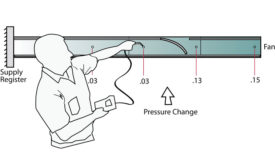David Richardson
David Richardson serves the HVAC industry as Vice President of Training for National Comfort Institute, Inc. (NCI). NCI specializes in training focused on improving, measuring, and verifying HVAC and Building Performance. If you’re an HVAC contractor or technician interested in learning more about building science applied to HVAC, contact David at ncilink.com/ContactMe.
ARTICLES
You have to identify the location of the airflow problem
Read More
Technicians Should Address Static Pressure Readings like a Doctor
Much like blood pressure tests, static pressure tests offer definitive diagnoses
Read More
Duct Dynasty: Designing the Ideal Duct System
An outline of how duct systems should be designed, fabricated, and assembled
Read More
Duct Dynasty: The Unintended Influences of Airflow on Combustion Safety
Altered airflow can influence the safe operation of fuel-fired equipment
Read More
Duct Dynasty: Increase Comfort with Performance-grade Registers and Grilles
Registers and grilles provide profitable opportunities for contractors
Read More
Duct Dynasty: Five Rules to Know About Airflow
Airflow is one of the most misunderstood aspects of an HVAC system
Read More
Duct Dynasty: Prevent Airflow Problems with Replacement Indoor Coils
Be sure to accurately measure pressure drop and acknowledge the number of fins per inch
Read More
Duct Dynasty: What Baseball Teaches Us About System Performance Testing
The sport shows us there is a repeatable method to achieve success
Read More
Copyright ©2024. All Rights Reserved BNP Media.
Design, CMS, Hosting & Web Development :: ePublishing










